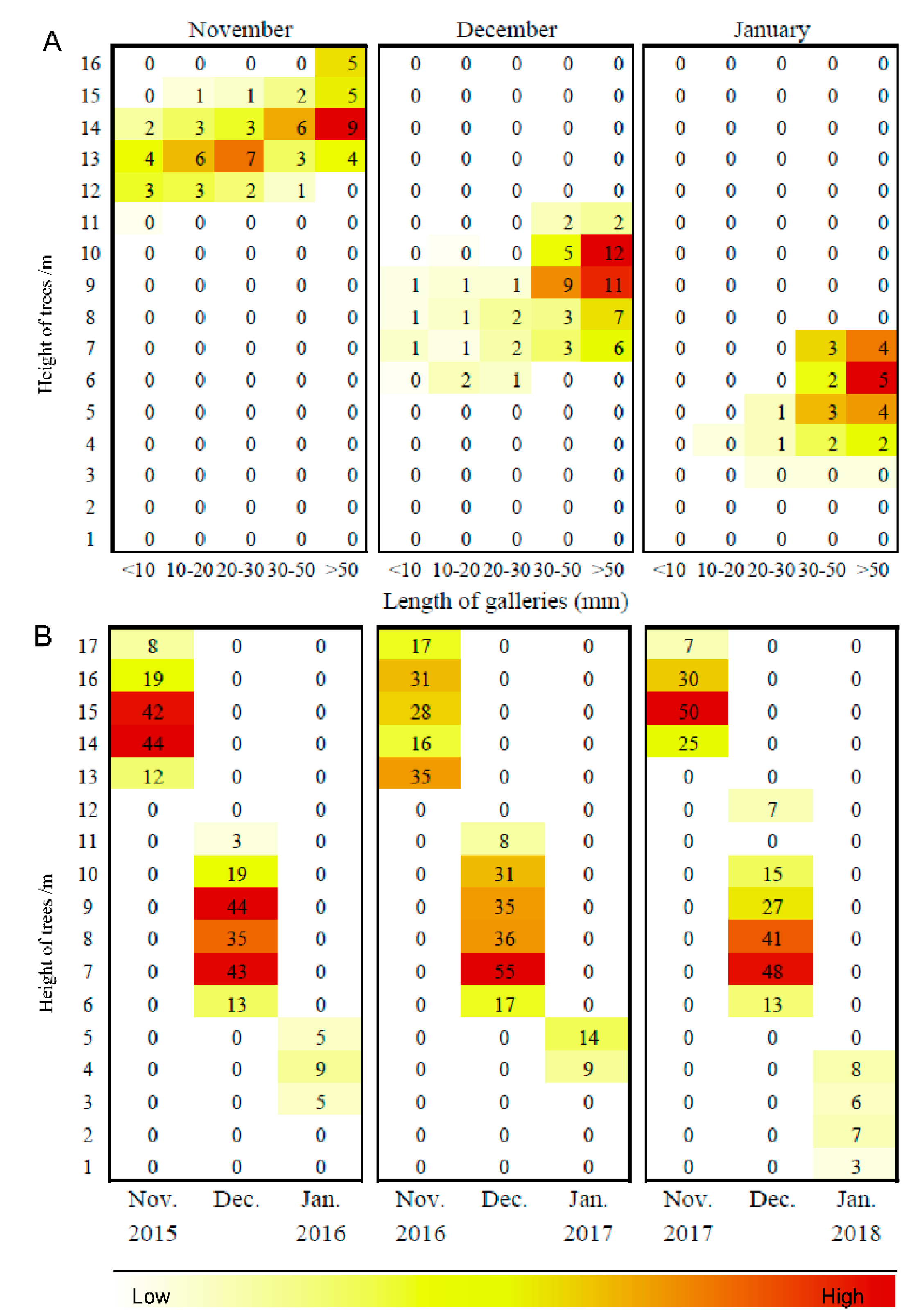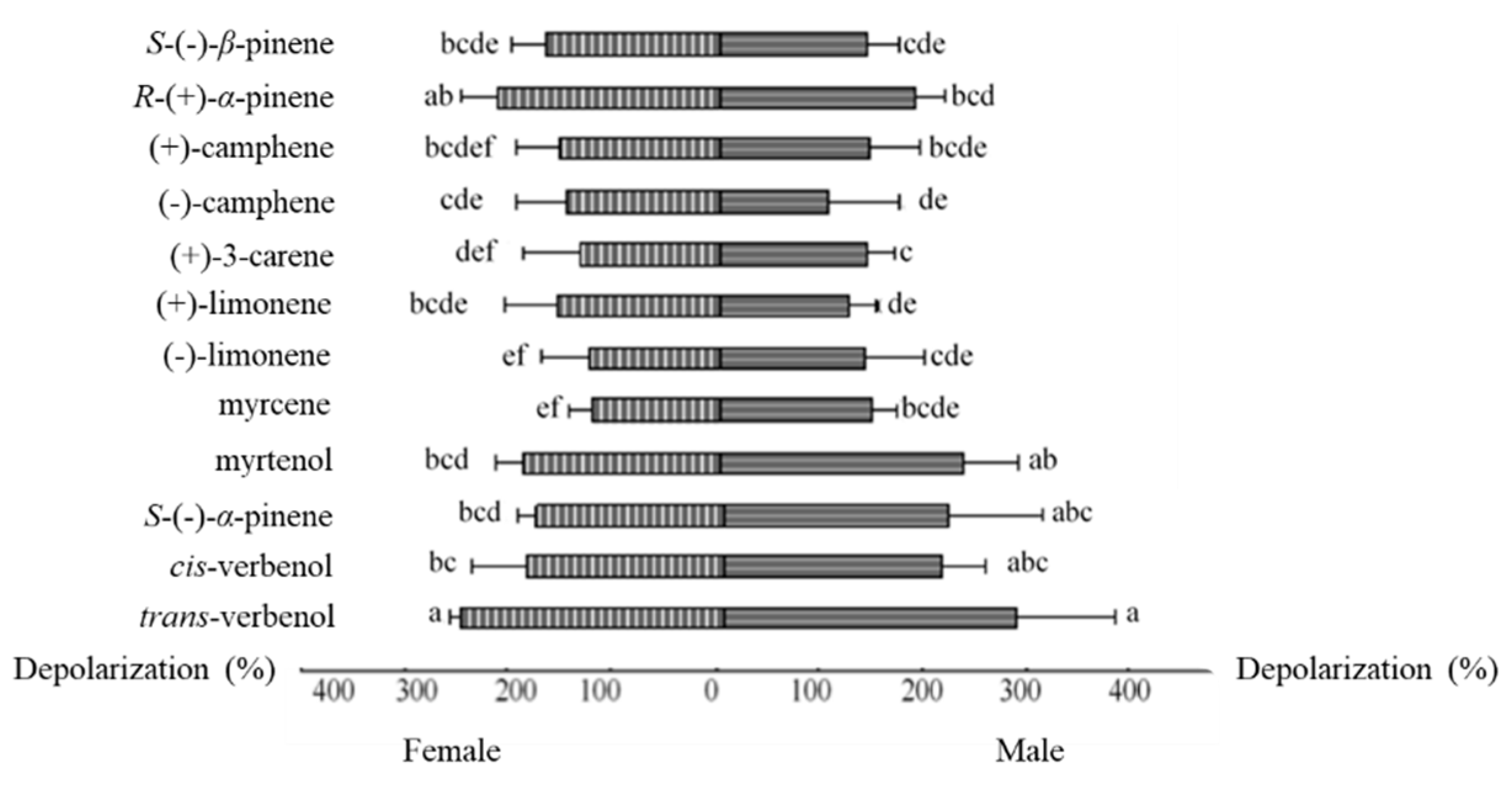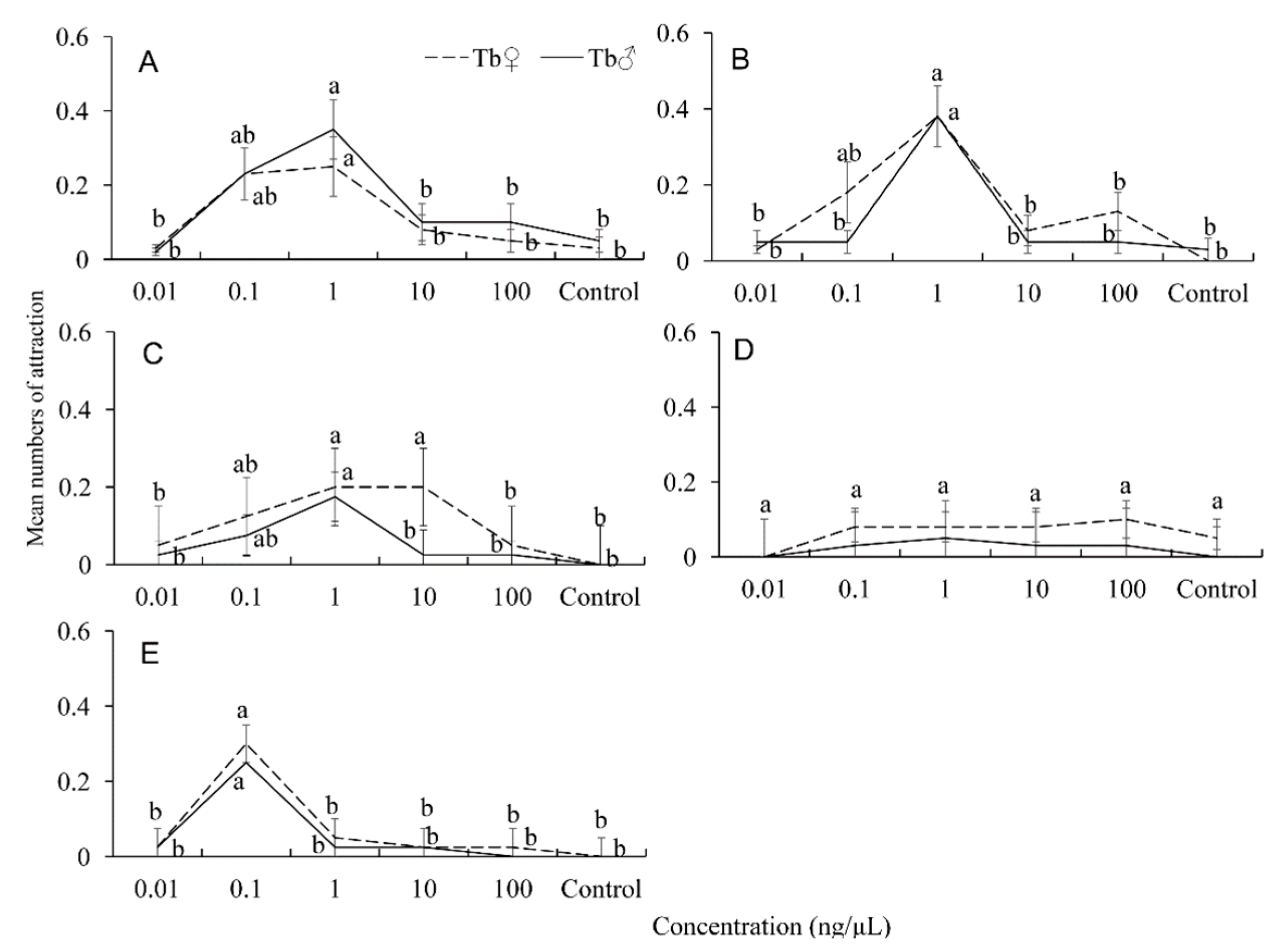Initial Location Preference Together with Aggregation Pheromones Regulate the Attack Pattern of Tomicus brevipilosus (Coleoptera: Curculionidae) on Pinus kesiya
Abstract
1. Introduction
2. Materials and Methods
2.1. Study Area
2.2. Insect Collection
2.3. Chemicals
2.4. Hindgut Extracts
2.5. Coupled Gas Chromatography-Mass Spectrometry (GC-MS)
2.6. Gas Chromatography–Electroantennographic Detection (GC-EAD)
2.7. Electroantennogram (EAG) Recording
2.8. Olfactometer Bioassays
2.9. Field Trapping
2.10. Statistical Analyses
3. Results
3.1. Population Dispersal on Trunk Surfaces
3.2. Chemical Analysis of Hindgut Extracts
3.3. GC-EAD Analyses
3.4. Electroantennography (EAG)
3.5. Olfactometer Bioassays
3.6. Field Trapping
4. Discussion
5. Conclusions
Author Contributions
Funding
Acknowledgments
Conflicts of Interest
References
- Bakke, A. Ecological studies on bark beetles (Coleoptera: Scolytidae) associated with Scots pine (Pinus sylvestris L.) in Norway, with particular reference to the influence of temperature. Medd. Nor. Skogforsøksves. 1968, 21, 441–602. [Google Scholar]
- Långström, B. Life cycles and shoot feeding of the pine shoot beetles. Stud. For. Suec. 1983, 163, 1–29. [Google Scholar]
- Långström, B.; Hellqvist, C. Induced and spontaneous attacks by pine shoot beetles on young Scots pine trees: Tree mortality and beetle performance. J. Appl. Entomol. 1993, 115, 25–36. [Google Scholar] [CrossRef]
- Peverieri, G.S.; Faggi, M.; Marziali, L.; Panzavolta, T.; Bonuomo, L.; Tiberi, R. Use of attractant and repellent substances to control Tomicus destruens (Coleoptera: Scolytidae) in Pinus pinea and P. pinaster pine forests of Tuscany. Entomologica 2016, 38, 91–102. [Google Scholar]
- Ye, H. Approach to the reasons of Tomicus piniperda (L.) population epidemics. J. Yunnan Univ. (Nat. Sci.) 1992, 14, 211–216. [Google Scholar]
- Ye, H.; Lieutier, F. Shoot aggregation by Tomicus piniperda L. (Col: Scolytidae) in Yunnan, southwestern China. Ann. For. Sci. 1997, 54, 635–641. [Google Scholar]
- Långström, B.; Li, L.S.; Hongpin, L.; Peng, C.; Haoran, L.; Hellqvist, C.; Lieutier, F. Shoot feeding ecology of Tomicus piniperda and T. minor (Col., Scolytidae) in southern China. J. Appl. Entomol. 2002, 126, 333–342. [Google Scholar] [CrossRef]
- Lu, J.; Zhao, T.; Ye, H. The shoot-feeding ecology of three Tomicus species in Yunnan province, southwestern china. J. Insect Sci. 2014, 14, 37. [Google Scholar] [CrossRef]
- Wang, J.H.; Zhang, Z.; Kong, X.B.; Wang, H.B.; Zhang, S.F. Intraspecific and interspecific attraction of three Tomicus beetle species during the shoot-feeding phase. Bull. Entomol. Res. 2015, 105, 225–233. [Google Scholar] [CrossRef]
- Byers, J.A. Attraction of bark beetles, Tomicus piniperda, Hylurgops palliates, and Trypodendron domesticum and other insects to short-chain alcohols and monoterpenes. J. Chem. Ecol. 1992, 18, 2385–2402. [Google Scholar] [CrossRef]
- Ye, H.; Li, L.S. The distribution of Tomicus piniperda (L) population in the crown of Yunnan pine during the shoot feeding period. Acta Entomol. Sin. 1994, 37, 311–316. [Google Scholar]
- Ye, H.; Ding, X.S. Impacts of Tomicus minor on distribution and reproduction of Tomicus piniperda (Col., Scolytidae) on the trunk of the living Pinus yunnanensis trees. J. Appl. Entomol. 1999, 123, 329–333. [Google Scholar]
- Lieutier, F.; Ye, H.; Yart, A. Shoot damage by Tomicus sp. (Coleoptera: Scolytidae) and effect on Pinus yunnanensis resistance to subsequent reproductive attacks in the stem. Agric. For. Entomol. 2003, 5, 227–233. [Google Scholar] [CrossRef]
- Ji, M.; Dong, X.Q.; Liu, H.P.; Li, L.S.; Xu, H.; Yang, X.P.; Li, H.R.; Ze, S.Z. Preliminary study on remote sensing detection of Yunnan pine forest damaged by Tomicus piniperda. J. West China For. Sci. 2007, 36, 87–90. [Google Scholar]
- Browne, F.G. Pests and Diseases of Forest Plantation Trees. An Annotated List of the Principal Species Occurring in the British Commonwealth; The Clarendon: Oxford, UK, 1968. [Google Scholar]
- Kirkendall, L.R.; Faccoli, M.; Ye, H. Description of the yunnan shoot borer, Tomicus yunnanensis kirkendall & Faccoli sp. n. (Curculionidae, Scolytinae), an unusually aggressive pine shoot beetle from southern china, with a key to the species of Tomicus. Zootaxa 2008, 1819, 25–39. [Google Scholar]
- Chen, P.; Lu, J.; Haack, R.A.; Ye, H. Attack pattern and reproductive ecology of Tomicus brevipilosus (Coleoptera: Curculionidae) on Pinus yunnanensis in southwestern china. J. Insect Sci. 2015. [Google Scholar] [CrossRef] [PubMed]
- Jia, P.; Li, J.Z.; Tong, Q.; Dai, Y.J.; Wan, L.M.; Liu, Y. The occurrence and distribution patterns of Tomicus brevipilosus adult in treetops (in Chinese). J. Southwest For. Univ. 2014, 6, 70–74. [Google Scholar]
- Wan, L.M.; Luo, F.M.; Tong, Q.; Dai, Y.J.; Jia, P.; Liu, Y. The spatial distribution patterns of Tomicus brevipilosus (Eggers) adults in trunk. J. Sichuan For. Sci. Tech. 2014, 35, 49–53. [Google Scholar]
- Byers, J.A.; Lanne, B.S.; Löfqvist, J.; Schlyter, F.; Bergström, G. Olfactory recognition of host-tree susceptibility. Naturwissenschaften 1985, 72, 324–326. [Google Scholar] [CrossRef]
- Byers, J.A. Chemical ecology of bark beetle. Experientia 1989, 45, 271–283. [Google Scholar] [CrossRef]
- Poland, T.M.; Groot, P.D.; Burke, S.; Wakarchuk, D.; Haack, R.A.; Nott, R.; Scarr, T. Development of an improved attractive lure for the pine shoot beetle, Tomicus piniperda (Coleoptera: Scolytidae). Agric. For. Entomol. 2003, 5, 293–300. [Google Scholar] [CrossRef]
- Schroeder, L.M. Attraction of the bark beetle Tomicus piniperda and some other bark- and wood-living beetles to the host volatiles a-pinene and ethanol. Entomol. Exp. Appl. 1988, 46, 203–210. [Google Scholar] [CrossRef]
- Poland, T.M.; De Groot, P.; Haack, R.A.; Czokajlo, D. Evaluation of semiochemicals potentially synergistic to a-pinene for trapping the larger European pine shoot beetle, Tomicus piniperda (Col., Scolytidae). J. Appl. Entomol. 2004, 128, 639–644. [Google Scholar] [CrossRef]
- Faccoli, M.; Anfora, G.; Tasin, M. Responses of the mediterranean pine shoot beetle Tomicus destruens (Wollaston) to pine shoot and bark volatiles. J. Chem. Ecol. 2008, 34, 1162–1169. [Google Scholar] [CrossRef] [PubMed]
- Lanne, B.S.; Schlyter, F.; Byers, J.A.; Löfqvist, J.; Leufvén, A.; Bergström, G.; Van Der Pers, J.N.C.; Unelius, R.; Baeckstrom, P.; Norin, T. Differences in attraction to semiochemicals present in sympatric pine shoot beetles, Tomicus minor, and T. piniperda. J. Chem. Ecol. 1987, 13, 1045–1067. [Google Scholar] [CrossRef] [PubMed]
- Zhao, T.; Li, L.S.; Zhou, N. The attraction of Yunnan pine to pine shoot beetle and tree volatile compositions. J. Northeast For. Univ. 2002, 30, 47–49. [Google Scholar]
- Sun, J.H.; Clarke, S.R.; Kang, L.; Wang, H.B. Field trials of potential attractants and inhibitors for pine shoot beetles in the Yunnan province, China. Ann. For. Sci. 2005, 62, 9–12. [Google Scholar] [CrossRef]
- Borden, J.H. Disruption of Semiochemical-Mediated Aggregation in Bark Beetles. In Insect Pheromone Resea: New Direction; Carde, R.T., Minks, A.K., Eds.; Chapman and Hall: New York, NY, USA, 1997; pp. 421–438. [Google Scholar]
- Schlyter, F. Semiochemical diversity in practice: Antiattractant semiochemicals reduce bark beetle attacks on standing trees-a first meta-analysis. Psyche J. Entomol. 2012. [Google Scholar] [CrossRef]
- Lindgren, B.S.; Borden, J.H. Displacement and aggregation of mountain pine beetles, Dendroctonus ponderosae (Coleoptera: Scolytidae), in response to their antiaggregation and aggregation pheromones. Can. J. For. Res. 1993, 23, 286–290. [Google Scholar] [CrossRef]
- Shea, P.J.; Neustein, M. Protection of a Rare Stand of Torrey Pine from Ips paraconfusus. In Application of Semiochemicals for Management of Bark Beetle Infestations; Salom, S.M., Hobson, K.R., Eds.; Plenum Press: Ogden, UT, USA, 1995; pp. 39–43. [Google Scholar]
- Zhang, Z.; Bian, L.; Sun, X.; Luo, Z.; Xin, Z.; Luo, F.; Chen, Z. Electrophysiological and behavioural responses of the tea geometrid Ectropis obliqua (Lepidoptera: Geometridae) to volatiles from a non-host plant, rosemary, Rosmarinus officinalis (Lamiaceae). Pest Manag. Sci. 2015, 71, 96–104. [Google Scholar] [CrossRef]
- Batista-Pereira, L.G.; Santangelo, E.M.; Stein, K.; Unelius, C.R.; Eiras, A.E.; Corrêa, A.G. Electrophysiological studies and identification of possible sex pheromone components of Brazilian populations of the sugarcane borer, Diatraea saccharalis. Z. Für Nat. C 2002, 57, 753–758. [Google Scholar] [CrossRef]
- Byers, J.A.; Birgersson, G.; Francke, W. Aggregation pheromones of bark beetles, Pityogenes quadridens and P. bidentatus, colonizing scotch pine: Olfactory avoidance of interspecific mating and competition. Chemoecology 2013, 23, 251–261. [Google Scholar] [CrossRef]
- Christiansen, E.; Waring, R.H.; Berryman, A.A. Resistance of conifers to bark beetle attack: Searching for general relationships. For. Ecol. Manag. 1987, 22, 89–106. [Google Scholar] [CrossRef]
- Cedervind, J.; Pettersson, M.; Långström, B. Attack dynamics of the pine shoot beetle, Tomicus piniperda (Col.; Scolytinae) in Scots pine stands defoliated by Bupalus piniaria (Lep.; Geometridae). Agric. For. Entomol. 2003, 5, 253–261. [Google Scholar] [CrossRef]
- Christiansen, E.; Bakke, A.; Christiansen, E.; Bakke, A. The Spruce Bark Beetle in Eurasia. In Dynamics of Forest Insects Populations; Berryman, A.A., Ed.; Plenum Press: New York, NY, USA, 1988; pp. 479–503. [Google Scholar]
- Flamm, R.O.; Coulson, R.N.; Payne, T.L. The Southern Pine Beetle. In Dynamics of Forest Insects Populations; Berryman, A.A., Ed.; Plenum Press: New York, NY, USA, 1988; pp. 531–553. [Google Scholar]
- Raffa, K.F.; Berryman, A.A. Interacting selective pressures in conifer-bark beetle systems: A basis for reciprocal adaptations? Am. Nat. 1987, 129, 234–262. [Google Scholar] [CrossRef]
- Rudinsky, J.A. Ecology of Scolytidae. Annu. Rev. Entomol. 1962, 7, 327–348. [Google Scholar] [CrossRef]
- Wood, D.L. The role of pheromones, kairomones, and allomones in the host selection and colonization behavior of bark beetles. Annu. Rev. Entomol. 1982, 27, 411–446. [Google Scholar] [CrossRef]
- Seybold, S.J.; Bohlmann, J.; Raffa, K.F. Biosynthesis of coniferophagous bark beetle pheromones and conifer isoprenoids: Evolutionary perspective and synthesis. Can. Entomol. 2000, 132, 697–753. [Google Scholar] [CrossRef]
- Cano-Ramírez, C.; Armendáriz-Toledano, F.; Macías-Sámano, J.E.; Sullivan, B.T.; Zúñiga, G. Electrophysiological and behavioral responses of the bark beetle Dendroctonus rhizophagus to volatiles from host pines and conspecifics. J. Chem. Ecol. 2012, 38, 512–524. [Google Scholar] [CrossRef]
- Ayres, B.D.; Ayres, M.P.; Abrahamson, M.D.; Teale, S.A. Resource partitioning and overlap in three sympatric species of Ips bark beetles (Coleoptera: Scolytidae). Oecologia 2001, 128, 443–453. [Google Scholar] [CrossRef]
- Song, L.W.; Ren, B.Z.; Sun, S.H.; Zhang, X.J.; Zhang, K.P.; Gao, C.Q. Field trapping test on semiochemicals of pine shoot beetle Tomicus piniperda L. J. Northeast For. Univ. 2005, 33, 38–40. [Google Scholar]
- Gallego, D.; Galián, J.; Diez, J.J.; Pajares, J.A. Kairomonal responses of Tomicus destruens (Col., Scolytidae) to host volatiles α-pinene and ethanol. J. Appl. Entomol. 2008, 132, 654–662. [Google Scholar] [CrossRef]
- Farooq, A.; Tahara, S.; Choudhary, M.I.; Attaur, R.; Ahmed, Z.; Başer, K.H.C.; Demirci, F. Biotransformation of (−)-α-pinene by Botrytis cinerea. Z. Für Nat. C 2002, 57, 303–306. [Google Scholar] [CrossRef]
- Divyashree, M.S.; George, J.; Agrawal, R. Biotransformation of terpenic substrates by resting cells of Aspergillus niger and Pseudomonas putida isolates. J. Food Sci. Tech. 2006, 43, 73–76. [Google Scholar]
- Seybold, S.J.; Huber, D.P.W.; Lee, J.C.; Graves, A.D.; Bohlmann, J. Pine monoterpenes and pine bark beetles: A marriage of convenience for defense and chemical communication. Phytochem. Rev. 2006, 5, 143–178. [Google Scholar] [CrossRef]
- Shi, Z.H.; Sun, J.H. Quantitative variation and biosynthesis of hindgut volatiles associated with the red turpentine beetle, Dendroctonus valens LeConte, at different attack phases. Bull. Entomol. Res. 2010, 100, 273–277. [Google Scholar] [CrossRef]





| Compounds | A | B | C | D | E | F | K |
|---|---|---|---|---|---|---|---|
| S-(−)-α-pinene | 10 | 10 | - | - | 5 | 5 | - |
| R-(+)-α-pinene | - | - | 10 | 10 | 5 | 5 | - |
| S-(−)-β-pinene | 1 | 1 | 1 | 1 | 1 | 1 | - |
| trans-verbenol | 0.025 | 0.0125 | 0.025 | 0.0125 | 0.0125 | 0.025 | - |
| cis-verbenol | - | 0.0125 | - | 0.0125 | 0.0125 | - | - |
| myrtenol | 0.5 | 0.5 | 0.5 | 0.5 | 0.5 | 0.5 | - |
| Retention Time | Component | Gender | Amount of Chemicals from Beetles Collected from Galleries of Different Length (in Nanograms) | ||||
|---|---|---|---|---|---|---|---|
| <10 mm † | 10–20 mm ‡ | 20–30 mm § | 30–50 mm ¶ | >50 mm ⊥ | |||
| 7:53 | styrene | female | 2.73 ± 0.49 a | 2.45 ± 0.62 a | 0.18 ± 0.06 b | 0.13 ± 0.04 b | 0.52 ± 0.18 b |
| male | 5.10 ± 0.18 a | 1.86 ± 0.53 a | 0.20 ± 0.13 a | 0.40 | 0.27 | ||
| 9:36 | α-pinene | female | 2.47 ± 1.25 b | 2.12 ± 0.50 b | 20.78 ± 5.58 a | 23.17 ± 4.90 a | 17.77 ± 6.03 a |
| male | 6.68 ± 4.46 a | 8.37 ± 7.39 a | 14.10 ± 4.94 a | 12.10 | 9.54 | ||
| 11:42 | S-(−)-β-pinene | female | 0.00 ± 0.00 b | 0.00 ± 0.00 b | 1.71 ± 1.01 ab | 2.49 ± 1.09 a | 0.00 ± 0.00 b |
| male | 0.00 ± 0.00 a | 0.00 ± 0.00 a | 1.53 ± 0.99 a | 0.00 | 0.00 | ||
| 14:33 | β-phellandrene | female | 0.94 ± 0.77 a | 0.21 ± 0.07 a | 3.46 ± 2.03 a | 5.77 ± 2.29 a | 3.69 ± 1.53 a |
| male | 2.24 ± 2.07 a | 0.50 ± 0.41 a | 3.23 ± 2.20 a | 0.68 | 0.45 | ||
| 18:94 | linalool | female | 0.76 ± 0.57 a | 0.17 ± 0.08 a | 0.23 ± 0.13 a | 0.56 ± 0.28 a | 1.09 ± 0.37 a |
| male | 0.26 ± 0.22 a | 1.08 ± 0.83 a | 0.88 ± 0.16 a | 0.95 | 0.90 | ||
| 21:63 | cis-verbenol | female | 6.82 ± 3.69 ab | 2.23 ± 0.52 ab | 0.65 ± 0.29 b | 0.69 ± 0.26 b | 19.77 ± 10.99 a |
| male | 4.61 ± 2.46 a | 3.30 ± 1.09 a | 0.43 ± 0.25 b | 1.27 | 2.24 | ||
| 21:87 | trans-verbenol | female | 0.87 ± 0.61 a | 0.66 ± 0.18 a | 0.27 ± 0.05 a | 1.39 ± 0.95 a | 0.55 ± 0.23 a |
| male | 0.76 ± 0.24 a | 0.39 ± 0.15 a | 0.20 ± 0.09 a | 0.12 | 0.20 | ||
| 24:29 | terpinen-4-ol | female | 0.35 ± 0.35 b | 0.13 ± 0.13 b | 0.37 ± 0.37 b | 0.31 ± 0.31 b | 11.61 ± 5.62 a |
| male | 0.07 ± 0.07 a | 0.05 ± 0.05 a | 0.18 ± 0.18 a | 0.20 | 0.56 | ||
| 24:99 | myrtenol | female | 102.24 ± 59.32 a | 40.29 ± 15.55 ab | 4.11 ± 1.40 b | 12.81 ± 5.23 b | 21.87±2.64 ab |
| male | 88.56 ± 40.22 a | 30.27 ± 10.84 a | 1.39 ± 0.34 b | 4.55 | 7.32 | ||
| 25:75 | verbenone | female | 4.63 ± 2.21 ab | 3.35 ± 0.94 ab | 0.49 ± 0.03 b | 1.33 ± 0.33 b | 10.41 ± 4.43 a |
| male | 9.35 ± 1.89 a | 5.61 ± 1.88 a | 1.12 ± 0.37 b | 0.52 | 2.59 | ||
© 2019 by the authors. Licensee MDPI, Basel, Switzerland. This article is an open access article distributed under the terms and conditions of the Creative Commons Attribution (CC BY) license (http://creativecommons.org/licenses/by/4.0/).
Share and Cite
Liu, F.; Wu, C.; Zhang, S.; Kong, X.; Zhang, Z.; Wang, P. Initial Location Preference Together with Aggregation Pheromones Regulate the Attack Pattern of Tomicus brevipilosus (Coleoptera: Curculionidae) on Pinus kesiya. Forests 2019, 10, 156. https://doi.org/10.3390/f10020156
Liu F, Wu C, Zhang S, Kong X, Zhang Z, Wang P. Initial Location Preference Together with Aggregation Pheromones Regulate the Attack Pattern of Tomicus brevipilosus (Coleoptera: Curculionidae) on Pinus kesiya. Forests. 2019; 10(2):156. https://doi.org/10.3390/f10020156
Chicago/Turabian StyleLiu, Fu, Chengxu Wu, Sufang Zhang, Xiangbo Kong, Zhen Zhang, and Pingyan Wang. 2019. "Initial Location Preference Together with Aggregation Pheromones Regulate the Attack Pattern of Tomicus brevipilosus (Coleoptera: Curculionidae) on Pinus kesiya" Forests 10, no. 2: 156. https://doi.org/10.3390/f10020156
APA StyleLiu, F., Wu, C., Zhang, S., Kong, X., Zhang, Z., & Wang, P. (2019). Initial Location Preference Together with Aggregation Pheromones Regulate the Attack Pattern of Tomicus brevipilosus (Coleoptera: Curculionidae) on Pinus kesiya. Forests, 10(2), 156. https://doi.org/10.3390/f10020156






